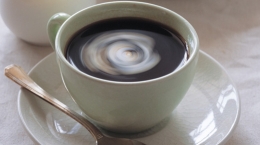
Excess
caffeine increases the likelihood of urinary incontinence in women, according
to a new study that echoes the findings of previous research.
Sept. 30, 2010 -- Excess caffeine increases the likelihood of urinary incontinence in women , according to a new study that echoes the findings of previous research.
''Women who consume high levels of caffeine are 70% more likely to have urinary incontinence than women who don't," says Jon Gleason, MD, an instructor and fellow at the University of Alabama at Birmingham Medical School's Division of Women's Pelvic Medicine and Reconstructive Surgery.
He is slated to present the findings Friday at the American Urogynecologic Society's annual meeting in Long Beach, Calif.
Caffeine sources include coffee, tea, beverages, foods, and some pharmaceuticals.
In Gleason’s study, women who reported taking in 329 milligrams of caffeine a day -- about three cups of coffee -- or more had a 70% higher likelihood of having the bladder problem.
Urinary incontinence , or the unintentional loss of urine, affects more than 13 million Americans, mostly women. Women are most likely to develop it either during pregnancy or childbirth or with menopause and its hormonal changes, due to pelvic muscle weakness. But it's not a natural consequence of aging, experts say.
Caffeine and Bladder Problems: The Study
Previous research has produced conflicting findings about caffeine and bladder problems, Gleason says. So he looked at a larger group of women than those studied in previous research.
Gleason evaluated data on 1,356 women, aged 20 to 85, who had participated in the 2005-2006 National Health and Nutrition Examination Survey, a large nationally representative survey.
The women kept food diaries on two separate days and also answered questions about bladder function.
Moderate caffeine intake, defined as about 182 milligrams a day, was not linked to urinary incontinence. But higher intakes -- 329.5 milligrams or higher -- were.
People who had a high caffeine intake were more likely to be aged 40-59, to drink alcohol, and to be non-Hispanic white.
Gleason found no links between urinary incontinence and body mass index , vaginal childbirth, or high intake of water.
What's Behind the Link?
''Only high levels of caffeine were associated with urinary incontinence," Gleason says.
What is it about the caffeine? "There is evidence that caffeine has a diuretic effect," he says. The diuretic effect increases the amount of urine you make.
Caffeine may also make the muscles that contract when you void overactive, he says.
Caffeine and Bladder Problems: Second View
The study findings are similar to those found by Lilly Arya, MD, an associate professor of obstetrics and gynecology at the University of Pennsylvania School of Medicine in Philadelphia, who published a study on caffeine and incontinence nearly a decade ago.
''What these studies are really finding [is that] high levels of caffeine are associated with urinary incontinence," she says.
Does it cause or aggravate the condition? "That's not known," says Arya, who reports doing consultant work for Pfizer, Astellas, and Duramed, makers of incontinence drugs or products.
Caffeine and Bladder Problems: Advice
The new study findings lend weight to advice many doctors already give, Arya says.
''For the woman with [bladder] problems, it should ideally be zero caffeine," she says. But she's realistic, knowing ''you have to be able to get through the day." So she tells these women, "Have a cup, one small cup, but make it as small as you can, definitely less than 8 ounces."
For women without bladder problems? "Up to two cups a day is generally fine. No bigger than 12 ounces, and the second cup should preferably be decaf."
"If you review all the caffeine literature, it seems like, in the U.S., up to two cups of coffee a day is considered moderate." What’s more difficult, she says, is defining a cup.
Years ago, she tells WebMD, researchers considered 5 ounces to be a ''standard" cup. "That's your grandma's china cup," she says.
These days, many researchers view an 8-ounce cup standard, she says. But coffee sold at outlets is often served in a much bigger cup.
At Starbucks, for instance, a short is 8 ounces but a tall is 12, a grande is 16, and a venti, 20 ounces.
WebMD Health News
by Kathleen Doheny
Reviewed By Laura
Martin
Last Modified: 2010/9/30 下午 03:18:48
研究發現,對於女性而言,過量咖啡因增加了尿失禁風險。
Sept.
30, 2010 – 根據呼應之前研究的一篇新研究,過量咖啡因增加了女性尿失禁的風險。
阿拉巴馬大學、伯明罕醫學院女性骨盆醫學與重建手術小組講師暨研究員Jon Gleason醫師表示,攝取大量咖啡因的女性有70%更可能發生尿失禁。
他被提名在週五於加州長灘舉辦的美國泌尿生殖協會年會中發表研究發現。
咖啡因的來源包括咖啡、茶、飲料、食物和某些藥物。
在Gleason醫師的研究中,每天攝取329 mg—約3杯咖啡 –以上的婦女,發生膀胱問題的可能性多出70%。
尿失禁或稱無意之漏尿, 影響了超過1,300萬名美國人,其中多數是女性。女性最可能在懷孕或分娩或停經和荷爾蒙狀態改變時發生失禁,這是因為骨盆肌肉虛弱,但是,並非老化的自然後遺症。
【咖啡因與膀胱問題之研究】
Gleason醫師表示,之前關於咖啡因和膀胱問題的研究結果各異,所以他以婦女樣本數多於以往的規模進行研究。
Gleason醫師評估了參與「2005-2006
National Health and Nutrition Examination Survey」這個大型全國代表性調查中、年紀在20-85歲之間的1,356名婦女的資料;婦女們記錄了兩天的飲食日記,也回答了有關膀胱功能的問卷。
中度咖啡因攝取(定義是每天約182 mg)與尿失禁無關,但是,攝取達329.5 mg以上則有關。
攝取咖啡因較多的婦女年紀多數為40-59歲者、會飲酒、為非西班牙裔白人。
Gleason醫師發現,尿失禁和身體質量指數、自然產、多喝水等無關。
【關聯的原因?】
Gleason醫師表示,只有大量咖啡因和尿失禁有關。
和咖啡因的關聯為何?他表示,證據是咖啡因有利尿效果,利尿效果增加了產生的尿量。
他表示,咖啡因也會在你膀胱過動時讓肌肉收縮。
【咖啡因和膀胱問題:其他專家觀點】
研究發現和賓州大學醫學院婦產科副教授Lilly Arya醫師的研究結果相似,Arya醫師在十年前發表過咖啡因和失禁的研究。
她表示,這些研究真正發現大量咖啡因和尿失禁有關。
它是引起或加重這個情況呢?Arya醫師表示,還不得而知。Arya醫師為製造失禁藥物或產品的Pfizer、Astellas和Duramed等藥廠擔任顧問。
【咖啡因和膀胱問題:建議】
Arya醫師表示,新研究發現為許多醫師們所做的建議增添支持性。
她表示,對於有膀胱問題的婦女,最好不要攝取咖啡因,但是,她知道,實際上要熬一天不簡單,所以她建議婦女只能喝一小杯、盡可能小杯,不要超過8盎司。
對於沒有膀胱問題的婦女呢?一天最多兩杯是還好,不要超過12盎司,且第二杯最好是低咖啡因的。
如果你回顧所有的咖啡因文獻,看起來差不多。在美國,每天最多兩杯咖啡被視為中度量,若定義為一杯是比較困難。
她在幾年前向WebMD表示,研究者將5盎司視為一杯標準杯,那大約是祖母用的瓷杯大小。
她表示,最近,許多研究者認為8盎司是一標準杯,但是,各通路販售的咖啡份量通常更多。例如,在星巴克,小杯是8盎司、中杯是12盎司,大杯是16盎司,超大杯是20盎司。





 留言列表
留言列表
 線上藥物查詢
線上藥物查詢 